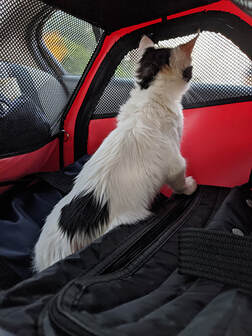
As creatures of habit who crave their creature comforts, cats don’t always make the best road trip companions. But by mapping out kitty’s trip together with your own, you can curtail her bad “backseat driver” behavior, and turn a potentially negative experience into a purr-fectly paws-itive one.
Consider the following suggestions to smooth the way for everyone – human and feline:
Remain calm. Because cats sense our stress, don’t raise your voice or display any overt signs of your own pre-trip tension.
Should your trip be longer than a day, make reservations ahead of time solely at pet-friendly motels or hotels.
Carry your most up-to-date vet paperwork, showing, at the very least, that your cat is current on her rabies shots.
Never medicate an overly anxious cat without first consulting your vet. Many OTC calming agents are dangerous for cats, and if you do use a medication prescribed by your vet, always try it out at home first to test for any reactions and/or side effects.
If your cat tends to get car sick, avoid feeding her between two and three hours prior to your departure.
Train your cat to wear a harness so that she can remain safely harnessed inside the car. Her harness should bear a nametag with all pertinent ID (microchipping is, of course, the best ID), and a leash should be clipped to it whenever you remove kitty from her carrier or from the car itself.
Have your cat travel comfortably by keeping her in a large carrier or dog crate, allowing her room enough to stretch and move around during the drive. Set the crate or carrier in a well-ventilated part of the car, out of excessive drafts and away from direct sunlight.
Drape a sheet over the crate or carrier, leaving one side open, to help her feel more snug, safe and secure.
Place a familiar blanket, several cushions, or a worn T-shirt with your scent on it inside the crate or carrier. Rotate various cat toys along the way (this works particularly well with a young kitten) to keep her stimulated and occupied.
Line the bottom with pee pads as a precaution and put a small, disposable litter pan (aluminum baking pans work well) inside the carrier or crate, and ensure you have a generous supply of both to last the entire trip. Stock up on sanitized wipes and strong plastic bags to handle any and all “litter box” accidents.
If your cat has an appetite, feed her the same food that she eats at home and keep her water bowl only partly filled to avoid spilling.
Never let your cat out of the car at “rest stops” unless she’s well trained to walk on a harness and leash. And above all, never leave kitty unattended -- on either hot or cold days.
As they say, forewarned is forearmed. Hopefully then, armed with these few tips, you and your cat can share a road trip to remember – fondly.









 RSS Feed
RSS Feed